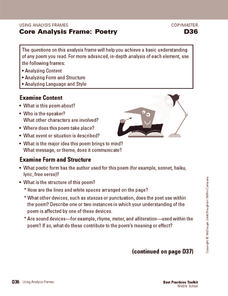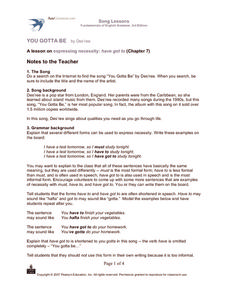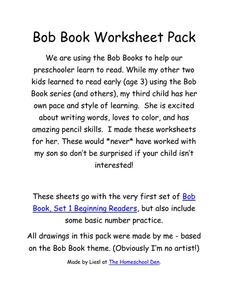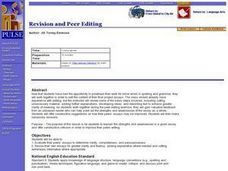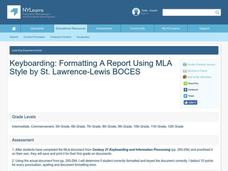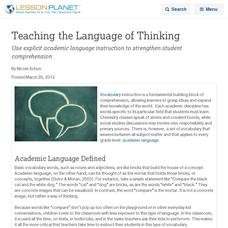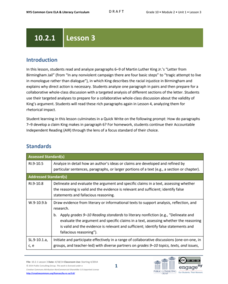Curated OER
Basic Visual Language Ii: How To Analyze a Visual Text
Students identify techniques used to communicate visually. They compare and contrast different visual techniques found in mass media. They apply their understanding by creating photographs that use a variety of visual literacy techniques.
Lincoln Public Schools
Developmental Strokes: Pre-Writing Worksheet
Young writers develop their fine motor skills one stroke at a time with this simple tracing worksheet. Looking at pictures of eight basic figures ranging from horizontal and vertical lines to circles and triangles, children practice...
Houghton Mifflin Harcourt
Core Analysis Frame: Poetry
Dig deep into any piece of poetry with a set of analysis questions. Ponder the content, form, and language of poetry and provide some question for critique. The first two pages include general questions, and the remainder of the document...
Azar Grammar
Song Lessons: You Gotta Be
Des'ree's song "You Gotta Be" is used to model for language learners the forms that can be used to express necessity (must, have to, have got to). After examining the grammar in the song, the attention switches to a discussion of the...
Curated OER
Thinking Spelling
An etymology resource is packed with suggestions for activities designed to build phonological, visual, morphemic, and etymological spelling skills.
Curated OER
The Art and History of Japanese Calligraphy
Chinese and Japanese calligraphy is beautiful and significant in both culture and tradition. Engage your class in this expressive fine art form through a lesson on using, holding, and creating brush strokes common to Japanese writing...
Curated OER
Grammar Lesson Plan: Simple Past vs. Present Perfect
What's the difference between the present perfect and simple past? Have your class practice identifying and using both of these verb tenses through pair activities, whole-class discussion, and a worksheet.
Teacher Created Materials
The Tragedy of Julius Caesar
Bring Julius Caesar to life with a reader's theatre approach that engages the entire class. The opening exercises model the importance of reading with expression while choral reading exercises permit class members to practice their...
San José State University
Organizational Patterns for the Comparison/Contrast Essay
Organization is key in essay writing. The two organizational charts included in this resource model the block approach and the point-by-point approach to organizing a compare and contrast style essay. After examining the charts, writers...
Homeschool Den
Bob Book Worksheet Pack
Practice fundamental reading and number skills with a packet of worksheets for early readers. Pupils find sight words, trace letters, and complete number sequences.
Houghton Mifflin Harcourt
Heroes: Extra Support Lessons (Theme 5)
This 32-page packet, designed for the Houghton Mifflin Harcourt thematic units on heroes, provides activities and exercises for those learners who need extra support to master the basic concepts in the units.
Curated OER
Daily Oral Language Activities in the Classroom
Daily Oral Language is a great way for you and your students to begin the day.
Curated OER
Language Arts: Revision and Peer Editing
Students are able to evaluate their peers' essays to determine clarity, completeness, and persuasiveness. They are able to revise their own essays for greater clarity and fluency, adding explanation where needed and cutting extraneous...
Curated OER
Daily Language Practice Builds Skills, Test Scores
Students develop their proofreading skills. In this daily language practice activity, students improve their writing skills as they edit passages. The editing work encompasses capitalization, punctuation, and grammar.
Curated OER
Writing Concise Sentences
Use this online English skills worksheet on a computer lab day in your language arts class. Young writers respond to twelve questions that require them to write more concise sentences. They may check suggested answers.
Curated OER
Keyboarding: Formatting a Report Using MLA Style
Keyboarding is one of the most basic skills needed to master modern technology, and it's also one of the most important. The class uses Century 21 Keyboarding and Information Processing to guide their hands in typing a report in the...
Curated OER
The Learning Network: More Like Disney
A great source of high-interest reading for the language arts classroom! Meant to be used with an article also available on the New York Times website, this worksheet provides 10 comprehension questions about the reading as well as one...
Curated OER
Historical Fiction Project
Students be engaged in a history project that is combined with Language Arts with the purpose of teaching students how to cite bibliographic information. This is important for doing future research.
Curated OER
“The Story of an Hour” Extension Activities: Teacher’s Guide and Notes
Enhance and extend instruction of "The Story of an Hour" by Kate Chopin with one or all of these ideas. You might want to cover characterization and summary, or improve understanding of context clues and irony. You can cover any...
Curated OER
Teaching the Language of Thinking
Use explicit instruction of academic language to strengthen student comprehension
CPALMS
Analyzing Vonnegut's View of the Future and His Commentary on the Present in Harrison Bergeron
Kurt Vonnegut's short story "Harrison Bergeron" engages adolescents with its theme about the dangers of complete societal equality. Learners complete a graphic organizer to track literary elements in the story, as well as an inference...
Curated OER
The Art of Protesting
Students view various images to examine different types of protest Americans have used throughout history, and explore ways in which protest can produce change for better or worse.
Houghton Mifflin Harcourt
Core Analysis Frame: Fiction
Dig into any piece of fiction with a series of analysis questions. There are two levels of questions provided: basic and in-depth. The basic questions can be copied double-sided onto a single piece of paper, while the in-depth questions...
EngageNY
Grade 10 ELA Module 2: Unit 1, Lesson 3
What are the four basic steps of any nonviolent campaign? Readers discover the answer by analyzing a letter written by Martin Luther King Jr. Lesson three involves discussion and analysis of King's claims in paragraphs seven through...




